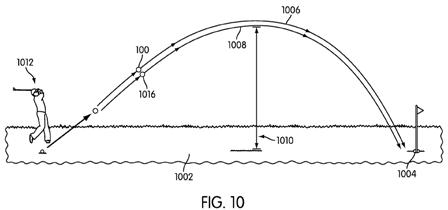What is with Nike Golf’s Love of Hydrophobic and Hydrophilic Coatings?
Well, it just makes sense. As I stated in a prior post, everything I read in their patent applications about hydrophobic and hydrophilic coatings seems like such a good idea (albeit one that sounds much easier to say than do) that I am left wondering whether it has been done before.
As you may recall, back in 2010 I posted about one of their patent applications directed to a golf club having hydrophobic and hydrophilic portions. Then, in 2011 I posted about a patent application directed to a golf ball with a hydrophilic coating such that when the ball gets wet the dimples become shallower and the coating becomes softer.
This week the love affair with hydrophilic and hydrophobic coatings continued as a patent application published as US Pub. No. A golf ball having hydrophilic and hydrophobic portions is disclosed. In wet playing conditions, moisture may be repelled by the hydrophobic portions and attracted to the hydrophilic portions. Thus, the surface of the hydrophobic portions may remain dry such that the friction between a golf club head and the golf ball surface is not reduced. As a result, the golf ball may not be adversely affected by wet playing conditions.
OK, so this one isn’t directed to swelling dimples like the prior application; rather it focuses on a ball with a portion of the surface that is hydrophobic and a portion of the surface that is hydrophilic. The hydrophilic portion of the surface may be adjacent the hydrophobic portion of the surface such that moisture is drawn away from the hydrophobic portion and drawn toward the hydrophilic portion. The hydrophilic portion of the surface may include multiple portions of the surface. The hydrophilic portions of the surface may be surrounded by the hydrophobic portion of the surface such that moisture is drawn away from the hydrophobic portion and drawn toward the hydrophilic portions.
Interesting stuff! The application goes on to explain:
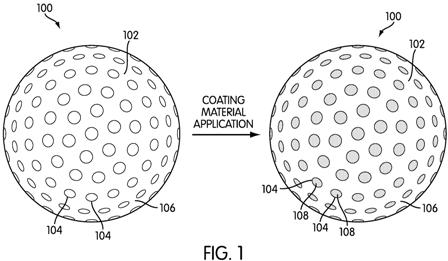
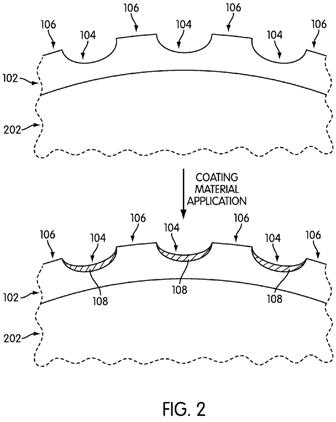
[0020] In the embodiment shown in FIG. 1, a coating material 108 may be selectively applied on dimples 304. In such an embodiment, coating material 108 may have a higher level of hydrophilicity than the level of hydrophilicity of the material of cover layer 102. Accordingly, after coating material 108 is applied to dimples 104, dimples 104 may have a higher level of hydrophilicity than the level of hydrophilicity of land area 106. Hydrophilic means attracting water and hydrophobic means repelling water. If dimples 104 are hydrophilic and land area 106 between dimples 104 is hydrophobic, then water may be drawn away from land area 106 toward the dimples 104. As a result, moisture may be less likely to collect on the surface of land area 106 and the surface of the land area 106 may be dryer than the land area on a conventional golf ball would be. The cover layers of conventional golf balls often become slick in moist or wet playing conditions. This moisture is a problem because it makes the club face slip as it contacts the golf ball. Also, the moisture present on the conventional golf ball may affect the aerodynamics of the golf ball and cause the golf ball to not travel as far as the golf ball would travel in dry playing conditions. Thus, preventing moisture from settling on land area 106 may prevent these problems associated with the presence of moisture on land area 106.
.
.
.
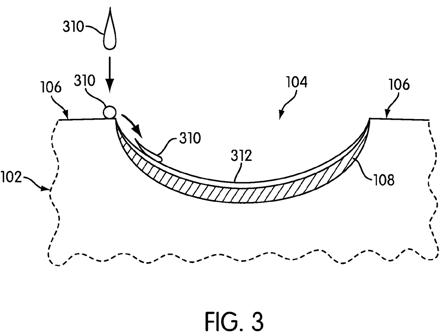
[0026] FIG. 3 illustrates how a water droplet 310 landing on land area 106 may be attracted to coating material 108 in dimples 104. Because cover layer 102, and thus land area 106, includes a hydrophobic material, water droplet 310 may be attracted away from land area 106 toward the more hydrophilic coating material 108 in dimples 104.
.
.
.
[0036] FIG. 10 shows a golfer 1012 golfing in fair (i.e., normal, or non-wet) weather conditions. Under these conditions, golf ball 100 (from the embodiment shown in FIG. 1) is in the dry state. Golf ball 100 may follow flight path 1006 toward the tee 1004, achieving a maximum vertical distance of 1010. For comparison, conventional golf ball 1016 is shown following a substantially similar flight path 1008. Conventional golf ball 1016 has the same general aerodynamic properties as golf ball 100 in the dry state.
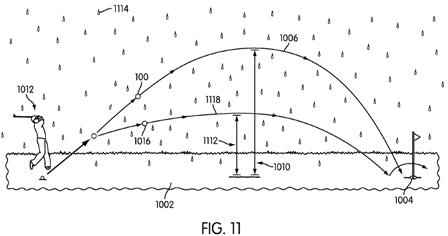
[0037] FIG. 11 shows golfer 1012 golfing in wet weather conditions. Specifically, rain 1014 lands on golf ball 100 and golf ball 1016, as well as the green 1002. As a result of being exposed to water in the form of rain 1114, the land area of golf ball 1016 becomes slick. As a result of the wet weather conditions, conventional golf ball 1016 experiences reduced friction between its cover layer and the golf club face during the shot. Therefore, conventional golf ball 1016 experiences a flight path trajectory 1118 having a lower maximum height 1112. Conventional golf ball 1016 also experiences reduced spin, resulting in poor control of the shot upon landing. In contrast, golf ball 100 compensates for wet playing conditions by repelling moisture from land area 106 and drawing moisture toward coating material 108. The reduced moisture on land area 106 prevents a loss of friction between the club face and land area 106. The reduced moisture also prevents reduced spin, thus preventing poor control of the shot upon landing. Accordingly, the present disclosure provides golf balls better able to compensate for wet weather conditions.
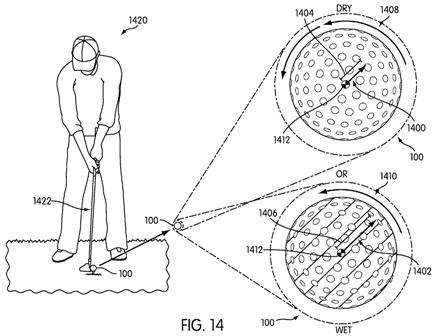
[0038] FIG. 14 illustrates a comparison between golf ball 100 when wet and dry. A golfer 1420 may swing a golf club 1422 toward golf ball 100 on a tee. If golf ball 100 is dry, then golf ball 100 may exhibit play characteristics as shown in the upper half of FIG. 14 upon being struck by golf club 1422. Specifically, golf ball 100 may exhibit a high rate of rotation 1408 around its center of gravity 1412 because less moisture may be present on coating material 108
in dry playing conditions. With less moisture present on coating material 108, the moment of inertia of dry ball 100, as graphically illustrated by the length 1404 of the moment arm 1400, may be relatively low. On the other hand, when golf ball 100 is wet, golf ball 100 may exhibit a lower rate of rotation 1410 about its center of gravity 1412 because more moisture may be present on coating material 108. With more moisture present on coating material 108, more weight may be concentrated on the surface of ball 100. As a result, the moment of inertia of wet ball 100, as graphically illustrated by the length 1406 of the moment arm 1402, may be relatively high. This effect on the moment of inertia of ball 100 may be more noticeable in embodiments with thicker coating materials, since more moisture may be attracted to thicker coating materials. Because golf ball 100 may display different play characteristics depending upon whether golf ball 100 is wet or dry, certain golfers may find it more desirable to use golf ball 100 in dry weather or wet weather based on the golfers’ preferences.
Amazing! Bet you never thought about the MOI of your wet golf ball before.
David Dawsey – Keeping an Eye on Golf Ball Patent Applications
PS – click HERE to read about a spin indicating golf ball that changes colors

